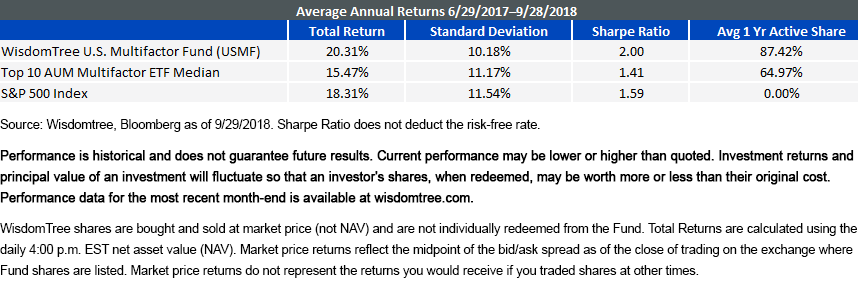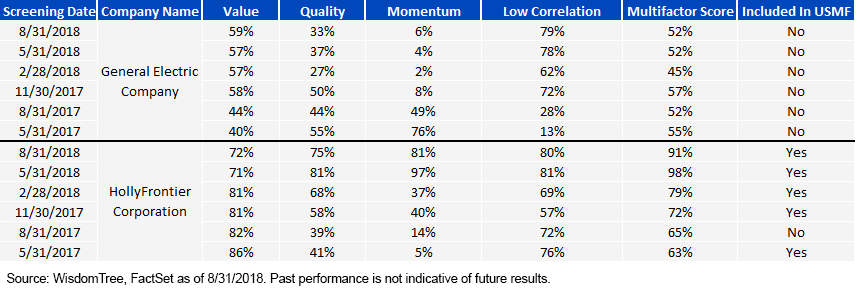What Makes This Fund One of the Best-Performing U.S. Multifactor Strategies?


This post was originally published on 07/10/2018 by: Christopher Carrano
The 10 largest Multifactor exchange-traded funds (ETFs) in the market hold over $10.5 Billion in assets and saw $1.8 billion of net inflows over the last fifteen months1. In the beginning of that time frame, specifically 6/29/2017, WisdomTree entered itself into the fray launching the WisdomTree U.S. Multifactor Fund (USMF). We are pleased to announce that since its inception, USMF outperformed all 10 of these Multifactor ETFs on both an absolute and risk-adjusted basis. In fact, of these 10 ETFs, USMF exhibited the third lowest volatility, with the 2 lower volatility ETFs achieving their risk reduction at the cost of being the worst 2 in performance.
In the below table we highlight median statistics, showcasing just how dominant USMF’s first fifteen months have been.

For standardized performance of USMF, please click here.
87% Active Share and High Value Added
We added Active Share to the above table, because we believe it’s an important aspect of USMF. Our Multifactor Strategy at its core is a stock picking strategy, informed by the factors Value, Quality, Momentum and Low Correlation. Given that our conviction in our factor-based stock selection model is high, we view more active share as increasing the chance for better fundamentals, superior returns, and less volatility than the market. This is also one reason why we incorporate sector neutrality and the low correlation factor, to help mitigate sector and market risk, and to magnify the effects of our high conviction stock picking.
Multifactor Transparency: How Does USMF Select Stocks?
We often hear that Multifactor ETF’s are too complicated and non-transparent. So, in the spirit of our commitment to being transparent, we wanted to walk through our 2 biggest single stock winners, both from an exclusion and inclusion standpoint. The below table shows a breakdown of our scoring system with 100% being the best possible score and 0% being the worst. We perform these calculations on all 800 stocks in our universe, and then select the top 200 stocks with the best aggregate Multifactor Score. Learn more about the strategy underlying each factor score.

Please click here for the holdings of General Electric Company and Holly Frontier Corporation in USMF.
- General Electric- As many know, GE has experienced a terrible performance over the last five quarters, and two months, dropping a little over 50% in value with an average weight in the S&P 500 over that time frame of .70%. From excluding this single stock, USMF has added roughly 115 basis points (bps) of outperformance vs the S&P 500 over the period. We can see at our first screening on 5/31/2017, GE’s Momentum score was decent at 76%, but mediocre Value and Quality scores, along with a low Low Correlation score kept it from inclusion. Since then, given its fall in price, GE’s value and low correlation scores have become more attractive, while its quality and momentum scores have continued to deteriorate, resulting in it being excluded from the basket. This is a good example of how our composite Multifactor scoring keeps us away from “value traps2”.
- HollyFrontier Corporation- This less-known energy company had an average weight of .56% in USMF since its inception while being absent entirely from the S&P 500. It has added roughly 50 bps to USMF’s relative outperformance vs the S&P 500. While some of its Value score has been lost over time, moving from 86% on 5/31/2017 to 72% on 8/31/2018, we have seen its quality score almost doubled, its momentum score go from 5% to 81%, and have even seen its low correlation score rise. This stocks Multifactor score is now in the top 10% of the investment universe. In many ways, this stock has been every investors dream, riding a deep value stock as it becomes a momentum stock with increasing quality. Interestingly, right around the time of 2018 stock market volatility is where we see momentum and low correlation begin to rise, as the market was down more than 7.5%, and HollyFrontier continued its consistent gains posting a positive .85% return, showing resilience in today’s market environment.3
Conclusion
USMF’s biggest losers due to stock selection were no surprise to us. Big name companies like Amazon, Microsoft and Netflix tend to have high correlations to the market and unfavorable valuations, which means their risk-adjusted momentum and quality metrics would have to be among the best in our universe to be included. However, USMF has shown over the past year that allocating more money to a company simply because it’s larger doesn’t have to be the status quo. In fact, at a time when those companies generally have been outperforming, USMF has still beat the market by over 2.0% annually, as well as the majority of other Multifactor ETFs beyond just the top 10 by AUM.
1Bloomberg as of 9/28/2018
2A value trap is a stock that appears cheap from a relative valuation perspective.
3Bloomberg, period referred to is 1/26/2018–3/29/2018
Important Risks Related to this Article
There are risks associated with investing, including possible loss of principal. Investing in a Fund exposed to particular sectors increases the vulnerability to any single economic, political or regulatory development. This may result in greater share price volatility. Due to the investment strategy of the Fund, it may make higher capital gain distributions than other ETFs. Please read the Fund’s prospectus for specific details regarding the Fund’s risk profile.

Alejandro Saltiel joined WisdomTree in May 2017 as part of the Quantitative Research team. Alejandro oversees the firm’s Equity indexes and actively managed ETFs. He is also involved in the design and analysis of new and existing strategies. Alejandro leads the quantitative analysis efforts across equities and alternatives and contributes to the firm’s website tools and model portfolio infrastructure. Prior to joining WisdomTree, Alejandro worked at HSBC Asset Management’s Mexico City office as Portfolio Manager for multi-asset mutual funds. Alejandro received his Master’s in Financial Engineering degree from Columbia University in 2017 and a Bachelor’s in Engineering degree from the Instituto Tecnológico Autónomo de México (ITAM) in 2010. He is a holder of the Chartered Financial Analyst designation.

